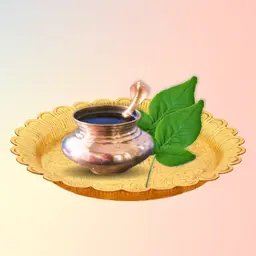
Description
In the rich spiritual tradition of Hinduism, offering Jal (holy water) and Bilva leaves (Bael Patra) to Lord Shiva holds immense significance. This age-old practice is not just a symbolic gesture but a deep act of devotion believed to invoke blessings, remove negativities, and bring peace, prosperity, and spiritual growth. From ancient temples like Omkareshwar Jyotirlinga to humble shrines across India, devotees perform this sacred offering daily, especially during auspicious months like Sawan (Shravan).
Why Offer Jal & Bilva Leaves to Lord Shiva?
Significance of Jal (Water)
Water, the universal purifier, is believed to cool the fiery energy of Lord Shiva, also known as Rudra. Offering water symbolizes humility, surrender, and purification. It is said to:
-
Cleanse past sins
-
Calm one’s mind and emotions
-
Invoke Shiva's grace and protection
Devotees offer Ganga Jal (holy water from the Ganges) or clean river water over the Shiva Linga while chanting mantras such as the Mahamrityunjaya Mantra or “Om Namah Shivaya.”
Significance of Bilva Leaves
Bilva (Bael) leaves are considered extremely dear to Lord Shiva. According to scriptures, each trifoliate leaf represents the three eyes of Shiva or the Holy Trinity — Brahma, Vishnu, and Mahesh. Offering Bilva leaves is believed to:
-
Remove doshas (flaws) and planetary obstacles
-
Bring health, wealth, and good fortune
-
Please Lord Shiva and invite divine blessings
The Skanda Purana says:
"Bilvasya patram shivaarpanam" – Offering a single Bilva leaf to Shiva brings merit equal to donating a thousand gold coins.
How to Perform the Ritual
Items Needed:
-
Clean copper pot (lotta) or kalash with Jal
-
Fresh Bilva leaves (with no holes or tears)
-
Sandalwood paste, white flowers, and incense
-
Optional: Ganga Jal, honey, milk, or curd
Step-by-Step Puja Process:
-
Clean yourself and the worship area.
-
Place a Shiva Linga (real or symbolic) on a platform or altar.
-
Chant "Om Namah Shivaya" or "Mahamrityunjaya Mantra" with full devotion.
-
Offer Jal slowly on the Shiva Linga, visualizing purification.
-
Place Bilva leaves one by one, ensuring the stalk side faces upward.
-
Offer flowers, light a diya, and complete the aarti.
Best Time to Offer Jal & Bilva Leaves
-
Mondays – Dedicated to Lord Shiva
-
Shravan Maas (July–August) – Most auspicious for Shiva worship
-
Mahashivratri – The night of cosmic transformation
-
Pradosh Vrat – Evening ritual twice a month
Spiritual Benefits
| Benefit | Explanation |
|---|---|
| Peace of Mind | Shiva worship calms the mind and removes negativity |
| Karma Cleansing | Helps wash away sins and karmic debt |
| Health & Healing | Bilva leaves are said to purify the body and cure diseases |
| Wealth & Prosperity | The act of offering with faith invites abundance |
| Divine Grace | Opens the heart to Shiva’s blessings and protection |
Cultural Relevance in Temples
At sacred Jyotirlingas like Omkareshwar, Kashi Vishwanath, Mahakaleshwar, and Kedarnath, this offering is a daily ritual. Even in household temples, millions of devotees practice this tradition, maintaining an unbroken chain of bhakti (devotion) that transcends time and geography.


